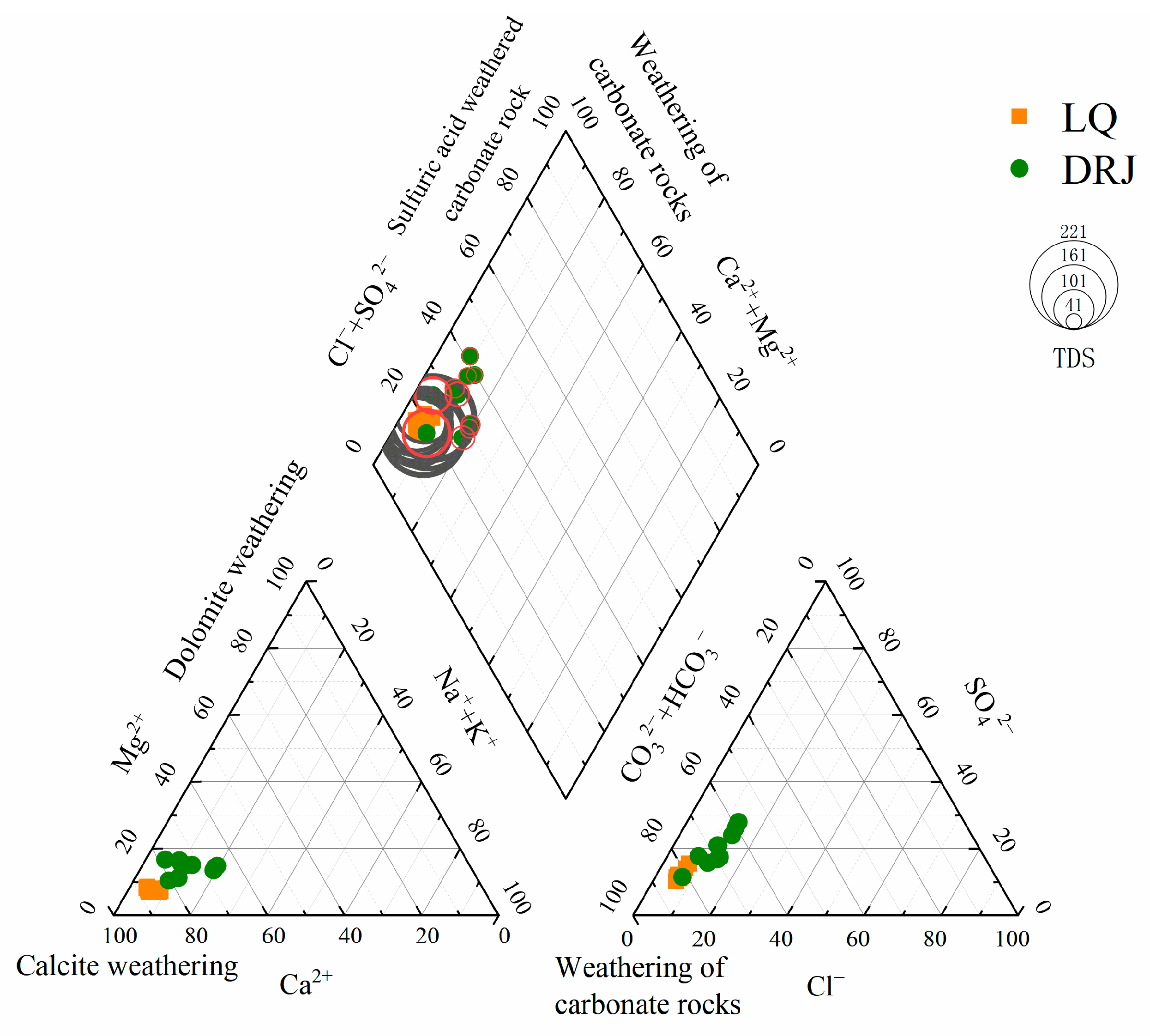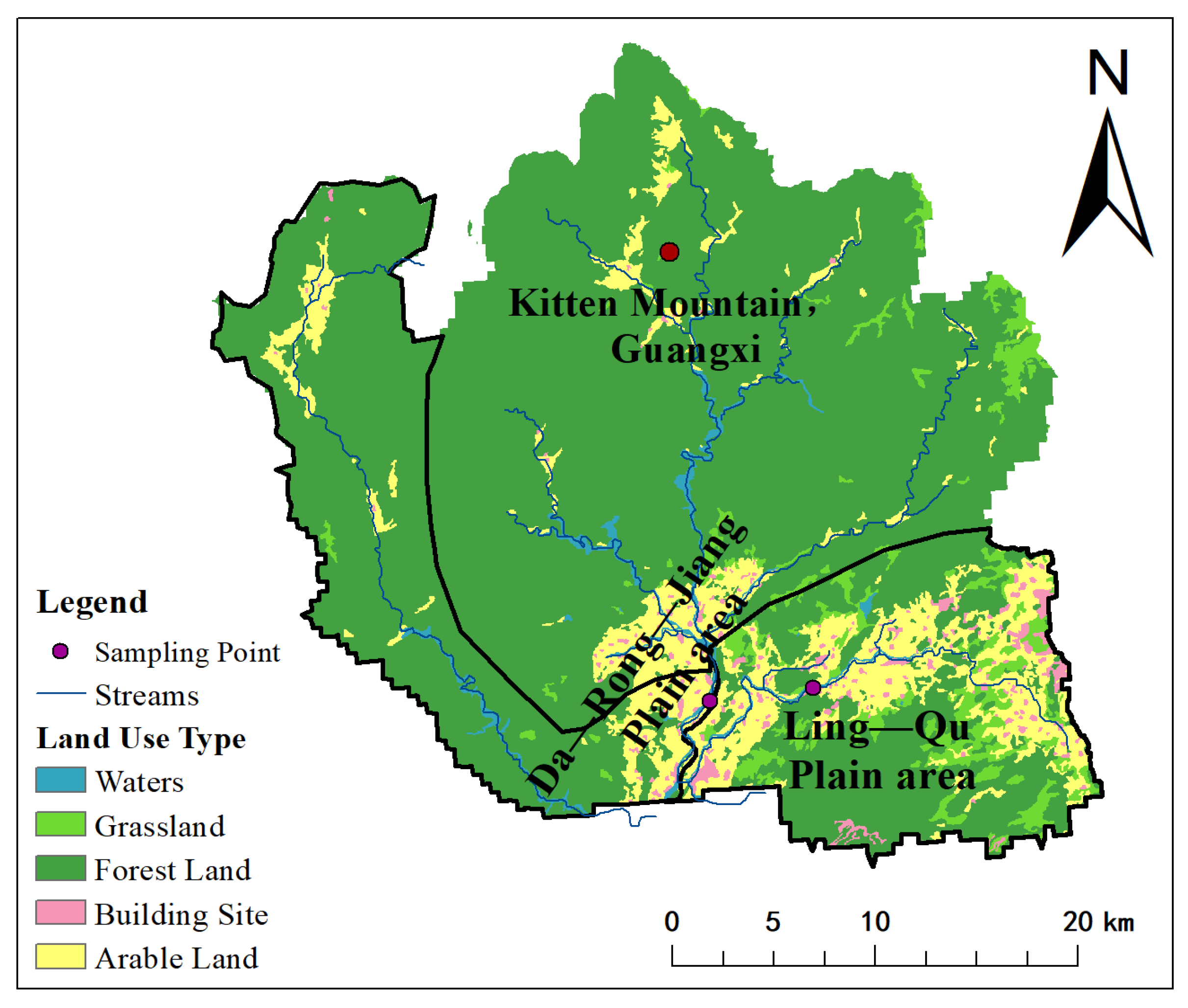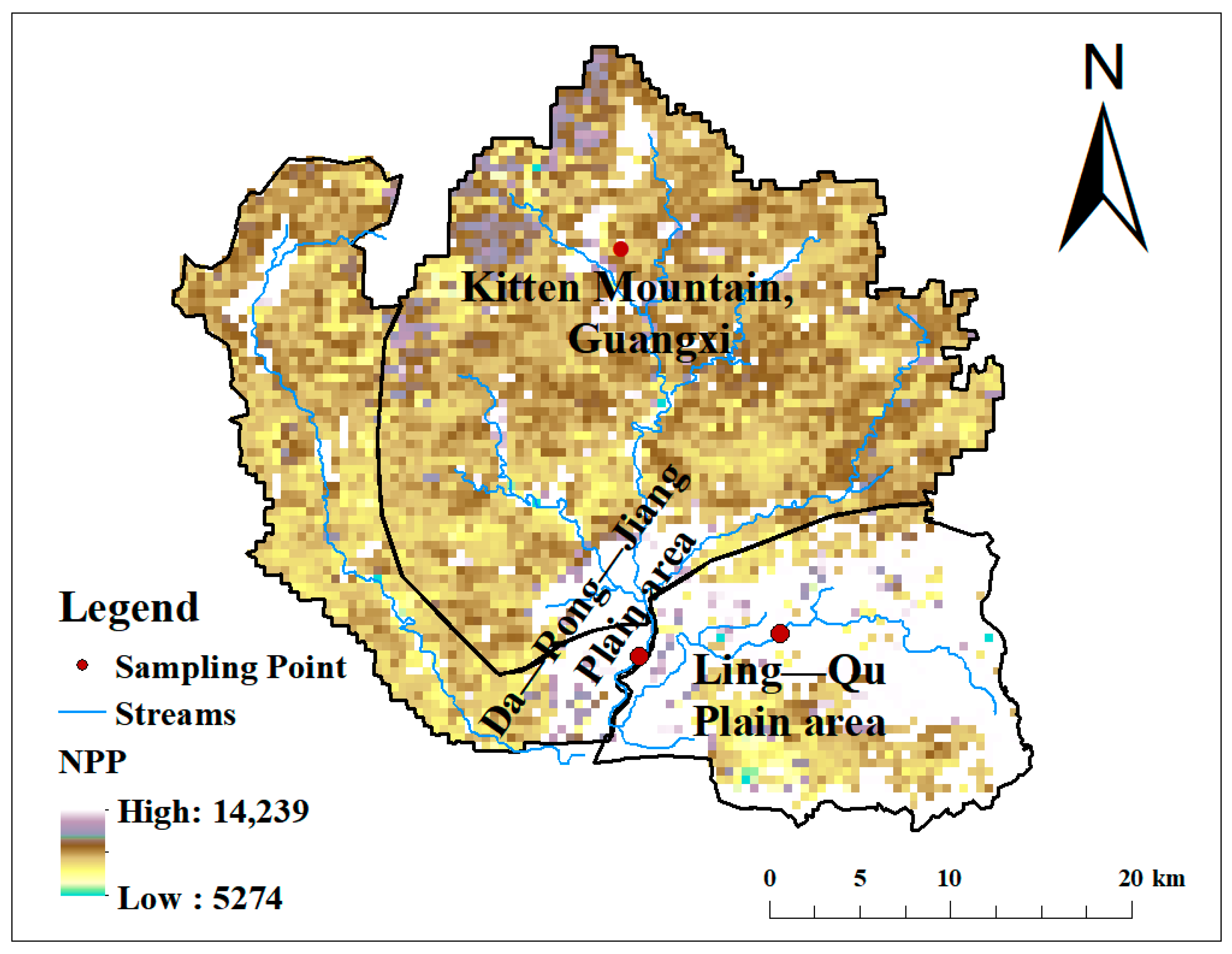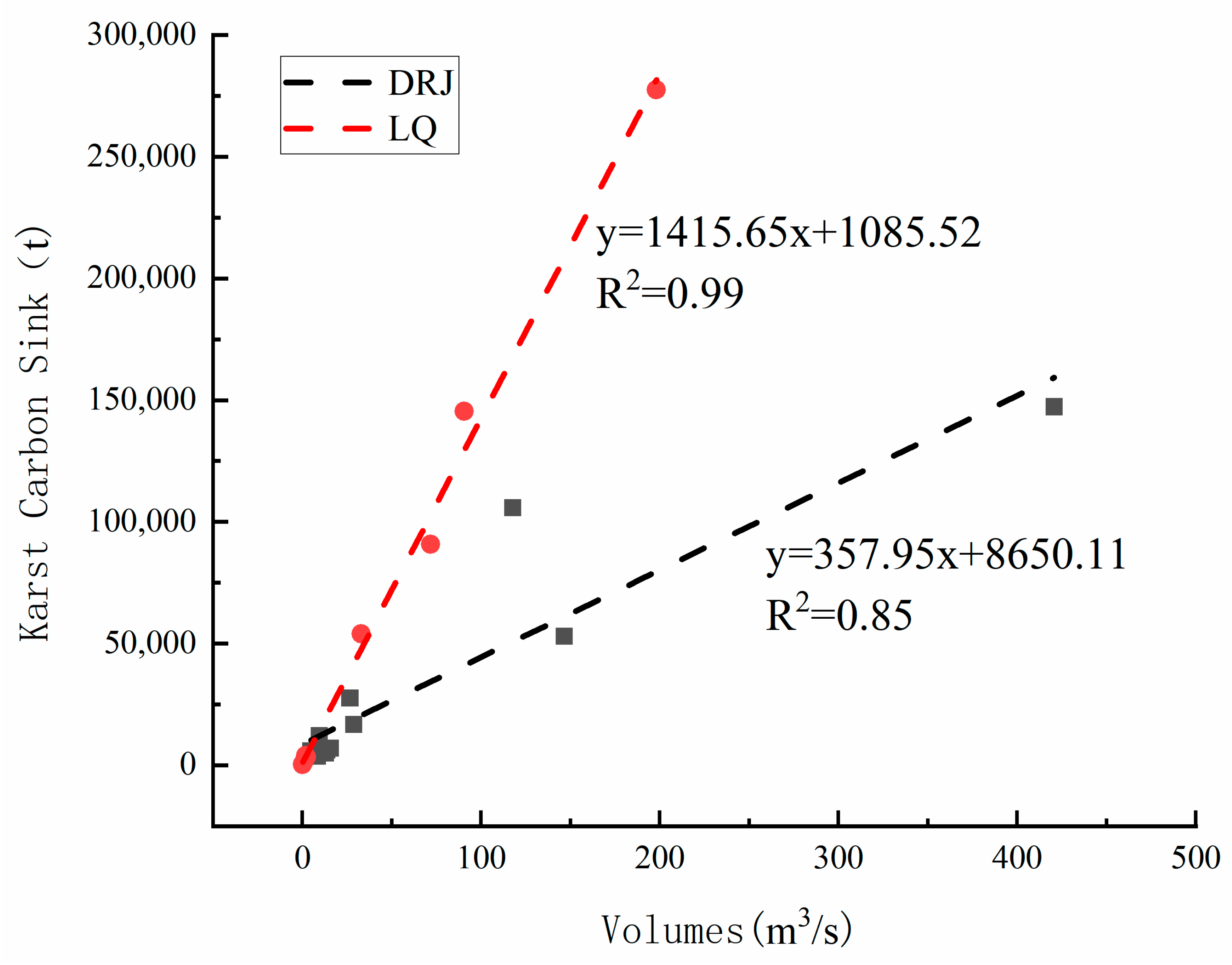Study on the Synergistic Effects of Karst Carbon Sink and Vegetation Carbon Sink in Watersheds under Different Geological Backgrounds—A Case Study of Darongjiang and Lingqu Watersheds
Abstract
:1. Introduction
2. Research Area Overview
3. Materials and Methods
3.1. Sample Collection and Testing
3.2. Data Processing
3.3. Hydrochemistry-Runoff Method
3.4. Calculation of FVCSF
4. Results
4.1. Hydrochemical Characteristics in the Study Area
4.2. Characteristics of KCS in the Watersheds
4.3. FVCSF in the Study Area
4.3.1. Status Quo of Land Use
4.3.2. The FVCSF in Watersheds
5. Discussion
5.1. Main Control Factors and Influence Factors of KCS in the Study Area
5.1.1. The Effect of Rock Weathering
5.1.2. The Effect of Vegetation Coverage
5.2. Comparative Analysis of FVCS Differences in the Study Area
5.3. Analysis of the Synergistic Effect between KCS and FVCS
6. Conclusions
- (1)
- The hydrochemical characteristics of the watersheds show that the content of Ca2+ and Mg2+ in the DRJ and LQ watersheds is relatively high, indicating that the water is mainly affected by carbonate rock weathering. In addition, the data from the study area further showed that the KCSF in DRJ and LQ watersheds is 238.43 × 105 t·y−1 and 353.44 × 105 t·y−1, respectively. In terms of seasonal changes, the KCSF in DRJ and LQ watersheds shows the following pattern: spring > summer > autumn > winter, and summer > spring > winter > autumn, respectively. Overall, both watersheds exhibit a higher KCSF in the rainy season than in the dry season, and the KCSF change is mainly controlled by flow rate change.
- (2)
- The annual FVCSF in DRJ and LQ watersheds is 680.78 × 107 t·y−1 and 229.63 × 107 t·y−1, respectively. Comparing the FVCSF with the KCSF, it can be found that the FVCSF is higher than the KCSF in both watersheds. Comparing the two watersheds, it can be found that the FVCSF is higher in the DRJ watershed than in the LQ watershed, which is related to the vegetation coverage of the study area. However, the KCSF is higher in the LQ watershed than in the DRJ watershed, which may be due to the larger proportion of carbonate rocks in the LQ watershed.
- (3)
- It was found that rock weathering has a certain influence on the development of karst carbon sinks in the study area. In addition, the amount of carbon sequestered by forest vegetation is also affected by rock weathering, which may be related to the fact that the upstream area is mostly mountainous woodland, and the strong weathering of rocks in the Lingqu River Basin promotes the development of vegetation carbon sinks. Therefore, it can be inferred that there is a certain synergistic effect between FVCS and KCS in the study area, and such a synergistic effect is caused by rock weathering. In addition, the synergistic effect of FVCS and KCS is more significant in the LQ watershed.
- (4)
- The data show that there is a certain mutual promotion mechanism between the karst action of carbonate rocks and the growth of vegetation. The systematic measurement of karst carbon sinks and vegetation carbon sinks in the study area on a watershed basis and the clarification of their mechanisms and quantification of sequestration/sink enhancement processes based on the data from the observation of the karst carbon cycle and vegetation carbon cycle in the study area will help to provide a basis for the assessment of the potentials of carbon sinks in karst areas and the sensitivity of the response to global change under the background of the target of “two-carbon”. This will help to provide a basis for assessing the potential of carbon sinks in karst areas and the sensitivity of global change responses in the context of the “dual carbon” target.
Author Contributions
Funding
Data Availability Statement
Acknowledgments
Conflicts of Interest
References
- Yang, H.; Ning, J.; Ma, Y.; Zhou, M.X.; Cao, J.H. Research progress on carbon cycle of karst vegetation in Southwest China. Guihaia 2022, 42, 903–913. [Google Scholar]
- Tang, X.; Zhao, X.; Bai, Y.; Tang, Z.; Wang, W.; Zhao, Y.; Wan, H.; Xie, Z.; Shi, X.; Wu, B.; et al. Carbon pools in China’s terrestrial ecosystems: New estimates based on an intensive field survey. Proc. Natl. Acad. Sci. USA 2018, 115, 4021–4026. [Google Scholar] [CrossRef] [PubMed]
- Wang, S.; Cui, Z.; Lin, J.J.; Xie, J.Y.; Su, K. The coupling relationship between urbanization and ecological resilience in the Pearl River Delta. J. Geogr. Sci. 2022, 32, 44–64. [Google Scholar] [CrossRef]
- Wang, C.; Zhang, Y.X. The realization path and policy system of the carbon neutral vision. Chin. J. Environ. Manag. 2020, 12, 58–64. [Google Scholar] [CrossRef] [PubMed]
- Bai, X.; Zhang, S.; Li, C.; Xiong, L.; Song, F.; Du, C.; Li, M.; Luo, Q.; Xue, Y.; Wang, S. A carbon-neutrality-capacity index for evaluating carbon sink contributions. Environ. Sci. Ecotechnol. 2023, 15, 100237. [Google Scholar] [CrossRef] [PubMed]
- Liu, Z.H. New progress and prospects in the study of rock-weathering-related carbon sinks. Chin. Sci. Bull. 2012, 57, 95–102. [Google Scholar] [CrossRef]
- White, A.F.; Buss, H.L. Natural Weathering Rates of Silicate Minerals. In Treatise on Geochemistry; The U.S. Geological Survey: Reston, VI, USA, 2013; pp. 115–155. [Google Scholar]
- China Future Research Society; China Society for Educational Development Strategies; College of Education, Peking University. Decision of the State Council on the Reform and Development of Basic Education. In Proceedings of the Fifth Forum of Chinese Scientists, Educators and Entrepreneurs; Standards Press of China: Beijing, China, 2006; pp. 151–159. [Google Scholar]
- Hou, N.; He, J.X.; Zhu, X.Q. Review of Research on Carbon Cycle of Terrestrial Ecosystems. Ecol. Econ. 2009, 10, 140–143. [Google Scholar]
- Wang, Q.F.; Liu, Y.H.; He, N.P.; Fang, H.J.; Fu, Y.L.; Yu, G.R. Demands and Key Scientific Issues in the Synthesis Research on Regional Terrestrial Ecosystem Carbon Budget in China. Prog. Geogr. 2012, 31, 78–87. [Google Scholar]
- Su, H.B.; Chen, X.J.; Wu, Y.L.; Xia, L.J.; Dai, F.Y.; Li, B.Z. Estimation of Vegetation Carbon Sinks in Jiangxi Province and Its Response to Climate Change. Acta Agric. Jiangxi 2023, 35, 127–135. [Google Scholar]
- Wei, Y.L.; Li, W.L.; Wang, L. The significance of karst carbon sink for carbon peak and carbon neutrality. China Min. Mag. 2022, 31, 212–214. [Google Scholar]
- Li, S.Q.; Gao, L.; Li, H.; Jiang, J.Y.; Huang, M.J.; Guo, M.; Zan, L.S. Study on spatial-temporal evolution and driving factors of forest vegetation carbon sequestration in state forest farms in Shaanxi Province. For. Econ. 2022, 44, 58–75. [Google Scholar]
- Zhang, L.; Wang, L.M.; Wang, R.B. Estimation of forest carbon storage and sequestration of shelterbelt in Upper And Middle Reaches of The Yangtze River. Resour. Environ. Yangtze Basin 2009, 18, 111–115. [Google Scholar]
- Zhang, Y.; Wu, L.L.; Su, F.; Yang, Z.G. Forest carbon sink research and carbon sink economy. Chin. J. Popul. Resour. Environ. 2010, 20, 288–291. [Google Scholar]
- Chen, W.H.; Cao, Z.J.; Wang, X.W. Game analysis of government supervision and forest farmers’ behavior in Forest Carbon Sequestration Reserve. Issues For. Econ. 2019, 39, 77–82. [Google Scholar]
- He, G.M.; Xu, B.; Wang, P.; Chen, S.Z. Analysis of forestry carbon sink trading development strategies under the background of the national unified carbon market. For. Econ. 2018, 40, 72–78. [Google Scholar]
- Huang, L.Y.; Dai, Y.W. The evolution of the frontiers of forestry finance research at home and abroad in the past 30 years: Based on the Visual Perspective of Knowledge Graph. Issues For. Econ. 2018, 38, 87–98+112. [Google Scholar]
- Li, X.X.; Pan, J.P. Comparative study on measurement methods of forest carbon sink. China For. Econ. 2020, 4, 96–97. [Google Scholar]
- Li, Y.W.; Bei, S.H. Thoughts on the development of carbon sequestration forestry in China. China For. Econ. 2020, 3, 42–45. [Google Scholar]
- Pan, R.; Shen, Y.Q.; Yang, H.; He, J.Y. Research of forest carbon sink demand in China. For. Econ. Issues 2020, 40, 14–20. [Google Scholar]
- Xiong, P. On the current situation development of forest carbon sink economy. China For. Econ. 2018, 2, 73–74. [Google Scholar]
- Brown, S.; Lugo, A.E. Biomass of Tropical Forests: A new estimate based on forest volumes. Science 1984, 223, 1290–1293. [Google Scholar] [CrossRef]
- Ketterings, Q.M.; Coe, R.; van Noordwijk, M.; Ambagau, Y.; Palm, C.A. Reducing uncertainty in the use of allometric biomass equations for predicting above-ground tree biomass in mixed secondary forests. For. Ecol. Manag. 2001, 146, 199–209. [Google Scholar] [CrossRef]
- Lan, X.; Du, H.; Song, T.Q.; Zeng, F.P.; Peng, W.X.; Liu, Y.X.; Fan, Z.L.; Zhang, J.Y. Carbon stock of major forest vegetation in Guangxi and its influencing factors. Ecol. Lett. 2019, 39, 2043–2053. [Google Scholar]
- Zhang, M.Y.; Wang, K.L.; Liu, H.Y.; Zhang, C.H.; Duan, Y.F. Vegetation carbon stock and density in Karst Area of Northwest Gui based on Remote Sensing Imagery. Chin. J. Ecol. Agric. 2013, 21, 1545–1553. [Google Scholar] [CrossRef]
- Huang, F.; Zhang, C.L.; Yang, H.; Cao, J.H.; Li, W.; Zhou, Y.C. Karst carbon cycle process at Watershed Scale: Karst process and carbon neutralization. Geol. Surv. China 2014, 1, 57–66. [Google Scholar]
- Yuan, D.X. Carbon cycle and global karst. Quat. Sci. 1993, 1, 1–6. [Google Scholar]
- Jiang, Z.C.; Zhang, C.; Luo, W.Q.; Xiao, Q.; Wu, Z.Y. Research progress and prospect of carbon sink in karst region of China. Carsologica Sin. 2022, 41, 345–355. [Google Scholar]
- Yuan, D.X. Progress in the Study on Karst Processes and Carbon Cycle. Adv. Earth Sci. 1999, 5, 425–432. [Google Scholar]
- Yuan, D.X. Carbon cycle and resource-environmental effects of the Earth system. Quat. Sci. 2001, 3, 223–232. [Google Scholar]
- Yuan, D.X.; Jiang, Z.C. Research progress of IGCP 379 Project “Karst Processes and the Carb on Cycles” in China. Hydrogeol. Eng. Geol. 2000, 1, 49–51. [Google Scholar]
- Wan, H.W.; Li, H.X.; Gao, J.X.; Sun, C.X.; Li, G.Y.; Gao, Y.H.; Li, Q. Study on the spatial pattern of carbon sequestration capacity enhancement potential of vegetation ecosystems in China. Ecol. Lett. 2022, 42, 8568–8580. [Google Scholar]
- Zhang, C. Carbonate rock dissolutio rates in different landuses and their carbon sink effect. Sci. Bull. 2011, 56, 2174–2180. [Google Scholar]
- Zhang, C.; Li, Y.H.; Wang, J.L.; Miao, Y.; Xiao, Q.; Guo, Y.L. Interface processes at Soil-Rock, Soil-Root Contacts and Subsoil Dissolution Rate in Shilin Geopark, Yunnan. Geol. Rev. 2020, 66, 1019–1030. [Google Scholar]
- Zhou, M.X.; Mo, B.Q.; Yang, H. Soil Karstification Intensity and Carbon Sink Effect of Plum Plantation in Karst Rocky Desertification Areas. Trans. Chin. Soc. Agric. Eng. 2020, 36, 116–123. [Google Scholar]
- Jiang, Z.C.; Jiang, X.Z.; Lei, M.T. Estimation of atmospheric CO2 sink of karst areas in China based on GIS and Limestone Tablet Loss Data. Carsologica Sin. 2000, 3, 16–21. [Google Scholar]
- Jiang, Z.C.; Yuan, D.X.; Cao, J.H.; Qin, X.Q.; He, S.Y.; Zhang, C. A study of carbon sink capacity of karst processes in China. Acta Geosci. Sin. 2012, 33, 129–134. [Google Scholar]
- Ni, J.; Luo, D.H.; Xia, J.; Zhang, Z.H.; Hu, G. Vegetation in karst terrain of southwestern China allocates more biomass to roots. Solid Earth 2015, 6, 799–810. [Google Scholar] [CrossRef]
- Wang, S.J.; Liu, Z.H.; Ni, J.; Yan, J.H.; Liu, X.M. A review of research progress and future prospective of carbon cycle in Karst Area of South China. Earth Environ. 2017, 45, 2–9. [Google Scholar]
- Hinggan County Local History Compilation Committee. Journal of Xing’an County (1991–2005); Wirecovered Books, Inc., 2013; pp. 93–99. [Google Scholar]
- Tang, Q.R. Xing’an County Water Conservancy Journal, County Journal. Guangxi People’s Publishing House: Nanning, China, 1999. [Google Scholar]
- Sun, P.A.; Yu, S.; Mo, F.Z.; He, S.Y.; Lu, J.F.; Yuan, Y.Q. Hydrochemical characteristics and influencing factors in different geological background: A case study in Darongjiang and Lingqu Basin, Guangxi, China. Environ. Sci. 2016, 37, 123–131. [Google Scholar]
- Liu, C.Y. Preliminary analysis of Minnan artificial afforestation technology and effects in Xing’an County, Guangxi. Agric. Technol. 2018, 38, 90–91. [Google Scholar]
- Xiao, Q.; Zhao, L.F.; Lu, L.M.; Sun, P.A.; Zhang, T.; Guo, Y.L. Spatial differences of soil physical and chemical properties in Darongjiang River Watershed. Carsologica Sin. 2021, 40, 815–824. [Google Scholar]
- Zhang, S.Y.; Xie, Q.; Huang, L.J.; Huang, Q.; Feng, X.Y.; Su, H.L. Niche analysis of main populations in Cyclobalanopsis glauca Community in Lingqu Basin of Guangxi, China. J. Guangxi Norm. Univ. 2021, 39, 162–173. [Google Scholar]
- Li, Z.J. Global Carbon Sink Estimates for Carbonate and Silicate Rock Weathering. Master’s Thesis, Guizhou Normal University, Guiyang, China, 2020. [Google Scholar]
- Li, B.; Yuan, D.X. Source-sink relationship between carbon cycle and atmospheric CO2 in karst areas—A case of karst areas in Guizhou (in English). China Karst. 1996, Z1, 47–55. [Google Scholar]
- Liu, M.Z.; Zhang, Y.X.; Chen, H.H. The studies on Carbon Cycle in Diaoshuihu Karst Regions of Jilin Province. Carsologica Sin. 1999, 2, 29–34. [Google Scholar]
- Liu, Z.H. Contribution of carbonate rock weathering to the atmospheric CO2 sink. Carsologica Sin. 2000, 4, 3–10. [Google Scholar]
- Liu, Z.H. Two important sinks of atmospheric CO2. Chin. Sci. Bull. 2000, 21, 2348–2351. [Google Scholar]
- Xu, S.Y.; Jiang, Z.C. Preliminary estimation of the Source-Sink relationship between Karstification and Atmospheric greenhouse gas CO2 in China. Chin. Sci. Bull. 1997, 9, 953–956. [Google Scholar]
- Chen, J.; Fan, W.; Li, D.; Liu, X.; Song, M. Driving factors of global carbon footprint pressure: Based on vegetation carbon sequestration. Appl. Energy 2020, 267, 114914. [Google Scholar] [CrossRef]
- Piper, A.M. A graphic procedure in the geochemical interpretation of water-analyses. Eos Trans. Am. Geophys. Union. 1944, 25, 914–928. [Google Scholar]
- Gibbs, R.J. Mechanisms controlling world water chemistry. Science 1970, 170, 1088–1090. [Google Scholar] [CrossRef]
- Liu, Z.; Dreybrodt, W.; Wang, H. A new direction in effective accounting for the atmospheric CO2 budget: Considering the combined action of carbonate dissolution, the global water cycle and photosynthetic uptake of DIC by aquatic organisms. Earth Sci. Rev. 2010, 99, 162–172. [Google Scholar] [CrossRef]
- Liu, J.Y.; Ning, J.; Kuang, W.H.; Xu, X.L.; Zhang, S.W.; Yan, C.Z.; Li, R.D.; Wu, S.X.; Hu, Y.F.; Du, G.M.; et al. Spatial and temporal patterns and new features of land use change in China, 2010–2015. J. Geogr. 2018, 73, 789–802. [Google Scholar]
- Field, C.B. Global net primary production: Combining ecology and remote sensing. Remote Sens. Environ. 1995, 51, 74–88. [Google Scholar] [CrossRef]
- Field, C.B.; Behrenfeld, M.J.; Randerson, J.T.; Falkowski, P.G. Primary production of the biosphere: Integrating terrestrial and oceanic components. Science 1998, 281, 237–240. [Google Scholar] [CrossRef] [PubMed]
- Yang, Y.D. Research on Sustainable Utilization of Water Resources in the Upper Reaches of the Lijiang River. Ph.D. Thesis, Central South University of Forestry and Technology, Changsha, China, 2005. [Google Scholar]
- Liu, S.L.; An, N.N.; Yin, Y.J.; Cheng, F.Y.; Dong, S.K. Relationship between Spatio-temporal Dynamics of Soil and Water Loss and NDVI of the Small Basins in the Middle Reaches of Lancang River based on SWAT Model. J. Soil Water Conserv. 2016, 30, 62–67. [Google Scholar]
- Zeng, C.; Liu, Z.H.; Zhao, M.; Yang, R. Hydrologically-driven variations in the karst-related carbon sink fluxes: Insights from high-resolution monitoring of three karst catchments in Southwest China. J. Hydrol. 2016, 533, 74–90. [Google Scholar] [CrossRef]
- Hindshaw, R.S.; Tipper, E.T.; Reynolds, B.C.; Lemarchand, E.; Bourdon, B. Hydrological control of stream water chemistry in a glacial catchment (Damma Glacier, Switzerland). Chem. Geol. 2011, 285, 215–230. [Google Scholar] [CrossRef]
- Ma, B.J.; Zhang, Q.F.; Li, S.Y. Characterization of water chemistry of transboundary rivers in China and its controlling factors. Quat. Stud. 2023, 43, 425–438. [Google Scholar]
- Abdullah, M.A.; Mohammed, Y.K.; Ahmed, A.A. Investigating the mineralogical and geochemical composition of fluvial sediments of Watari river system, Kano, Nigeria. Kuwait J. Sci. 2024, 51, 100151. [Google Scholar]
- Yan, Z.X.; Feng, M.Q. Hydrochemical characteristics and driving factors of surface water in the mining area of Changhe River Basin. Environ. Chem. 2022, 41, 632–642. [Google Scholar]
- Kang, Z.; Chen, J.; Yuan, D.; He, S.; Zhang, Q. Promotion function of forest vegetation on the water & carbon coupling cycle in karst critical zone: Insights from karst groundwater systems in South China. J. Hydrol. 2020, 125246. [Google Scholar]
- Zhang, M.; Yang, W.; Yang, M.; Yan, J. Guizhou Karst Carbon Sink and Sustainability—An Overview. Sustainability 2022, 14, 11518. [Google Scholar] [CrossRef]
- Yu, S.; Pu, J.B.; Liu, F.; Yang, H. Effect of vegetation on Carbon Sequestration in Karst Systems—A Critical Review. Earth Sci. Front. 2023, 30, 418–428. [Google Scholar]
- Dai, T.R.; Dai, X.A.; Lu, H.; He, T.; Li, W.L.; Li, C.; Huang, S.Q.; Huang, Y.Y.; Tong, C.B.; Qu, G.; et al. The impact of climate change and human activities on the change in the net primary productivity of vegetation-taking Sichuan Province as an example. Environ. Sci. Pollut. Res. Int. 2023, 31, 7514–7532. [Google Scholar] [CrossRef] [PubMed]
- Zhu, S.; Cao, J.H.; Yang, H.; Liang, J.H.; Lao, C.L. A review of the interaction mechanism and law between vegetation and rock geochemical background in Karst Areas. Rock Miner. Anal. 2023, 42, 59–71. [Google Scholar]
- Wang, C.; Li, W.; Shen, T.; Cheng, W.; Yan, Z.; Yu, L. Influence of soil bacteria and carbonic anhydrase on karstification intensity and regulatory factors in a typical karst area. Geoderma 2018, 313, 17–24. [Google Scholar] [CrossRef]
- Huang, Q.B. Study on Karst Carbon Sink Processes and Effects in Semi-Arid Karst Areas in Northern China. Ph.D. Thesis, China University of Geosciences, Wuhan, China, 2019. [Google Scholar]






| Sampling Point | Parameter | Temp./°C | pH | EC/μs·cm−1 | Cations and Anion in Water/mg·L−1 | |||||||
|---|---|---|---|---|---|---|---|---|---|---|---|---|
| Ca2+ | K+ | Mg2+ | Na+ | Cl− | SO42− | HCO3− | NO3− | |||||
| DRJ | Max. | 25.76 | 8.14 | 171.90 | 26.09 | 0.98 | 2.41 | 2.96 | 3.94 | 11.07 | 79.29 | 8.16 |
| Min. | 11.30 | 6.79 | 43.60 | 5.52 | 0.54 | 0.70 | 0.38 | 2.96 | 5.43 | 22.85 | 3.23 | |
| Avg. | 19.28 | 7.68 | 78.10 | 11.56 | 0.75 | 1.29 | 1.56 | 3.35 | 7.81 | 40.20 | 5.43 | |
| CV | 0.26 | 0.05 | 0.50 | 0.51 | 0.20 | 0.40 | 0.61 | 0.09 | 0.23 | 0.46 | 0.26 | |
| LQ | Max. | 28.56 | 8.46 | 318.00 | 50.88 | 1.86 | 2.62 | 4.95 | 7.00 | 20.89 | 154.97 | 8.55 |
| Min. | 10.32 | 7.57 | 162.10 | 27.81 | 0.98 | 1.34 | 0.54 | 3.66 | 11.17 | 79.96 | 5.42 | |
| Avg. | 20.29 | 8.09 | 233.21 | 39.20 | 1.34 | 2.05 | 2.56 | 5.18 | 13.88 | 116.21 | 7.16 | |
| CV | 0.31 | 0.03 | 0.21 | 0.20 | 0.20 | 0.20 | 0.60 | 0.23 | 0.18 | 0.18 | 0.12 | |
| Time | KCSF (t) | HCO3− Concentration (mg/L) | Flow Rate (m3/s) | |||
|---|---|---|---|---|---|---|
| DRJ | LQ | DRJ | LQ | DRJ | LQ | |
| Spring | 115.36 × 105 | 147.72 × 105 | 153.74 | 339.64 | 290.70 | 164.77 |
| Average | 384.54 × 104 | 492.40 × 104 | 51.25 | 113.21 | 96.90 | 54.92 |
| Coefficient of variation | 0.50 | 0.71 | 0.41 | 0.28 | 0.53 | 0.69 |
| Summer | 103.10 × 105 | 203.03 × 105 | 84.21 | 319.29 | 462.24 | 231.80 |
| Average | 343.68 × 104 | 676.78 × 104 | 28.07 | 106.43 | 154.08 | 77.27 |
| Coefficient of variation | 1.14 | 1.08 | 0.22 | 0.13 | 1.22 | 1.12 |
| Autumn | 103.96 × 104 | 571.51 × 102 | 94.87 | 366.07 | 35.97 | 0.50 |
| Average | 346.53 × 103 | 190.50 × 102 | 31.62 | 122.02 | 11.99 | 0.17 |
| Coefficient of variation | 0.24 | 0.05 | 0.11 | 0.07 | 0.32 | 0.05 |
| Winter | 95.41 × 104 | 211.70 × 103 | 149.65 | 369.51 | 22.38 | 2.11 |
| Average | 318.04 × 103 | 705.66 × 102 | 49.88 | 123.17 | 7.46 | 0.70 |
| Coefficient of variation | 0.20 | 0.96 | 0.43 | 0.13 | 0.27 | 1.06 |
| KCSFtotal (t·y−1) | DRJ | 238.43 × 105 | LQ | 353.44 × 105 | ||
| Type | Area (km2) | Percentage (%) |
|---|---|---|
| Cultivated land | 133.22 | 11.64 |
| Forest | 923.88 | 80.69 |
| Grassland | 53.25 | 4.65 |
| Water | 16.94 | 1.48 |
| Urban, rural, industrial, and mining residential lands | 17.66 | 1.54 |
| Project | Unit Area (g/m2) | FVCSF (t·y−1) | ||
|---|---|---|---|---|
| DRJ | LQ | DRJ | LQ | |
| Max. | 39,101.89 | 50,852.38 | 8,205,613.04 | 6,134,352.98 |
| Min. | 20,559.73 | 19,103.60 | 4,314,503.44 | 2,304,478.68 |
| Avg. | 18,542.15 | 31,748.78 | 3,891,109.60 | 3,829,874.30 |
| Sum | 324.41 × 105 | 190.36 × 105 | 680.78 × 107 | 229.63 × 107 |
Disclaimer/Publisher’s Note: The statements, opinions and data contained in all publications are solely those of the individual author(s) and contributor(s) and not of MDPI and/or the editor(s). MDPI and/or the editor(s) disclaim responsibility for any injury to people or property resulting from any ideas, methods, instructions or products referred to in the content. |
© 2024 by the authors. Licensee MDPI, Basel, Switzerland. This article is an open access article distributed under the terms and conditions of the Creative Commons Attribution (CC BY) license (https://creativecommons.org/licenses/by/4.0/).
Share and Cite
Wang, X.; Tang, X.; Yu, S.; Zhong, X. Study on the Synergistic Effects of Karst Carbon Sink and Vegetation Carbon Sink in Watersheds under Different Geological Backgrounds—A Case Study of Darongjiang and Lingqu Watersheds. Water 2024, 16, 1192. https://doi.org/10.3390/w16081192
Wang X, Tang X, Yu S, Zhong X. Study on the Synergistic Effects of Karst Carbon Sink and Vegetation Carbon Sink in Watersheds under Different Geological Backgrounds—A Case Study of Darongjiang and Lingqu Watersheds. Water. 2024; 16(8):1192. https://doi.org/10.3390/w16081192
Chicago/Turabian StyleWang, Xue, Xiangling Tang, Shi Yu, and Xuemei Zhong. 2024. "Study on the Synergistic Effects of Karst Carbon Sink and Vegetation Carbon Sink in Watersheds under Different Geological Backgrounds—A Case Study of Darongjiang and Lingqu Watersheds" Water 16, no. 8: 1192. https://doi.org/10.3390/w16081192




